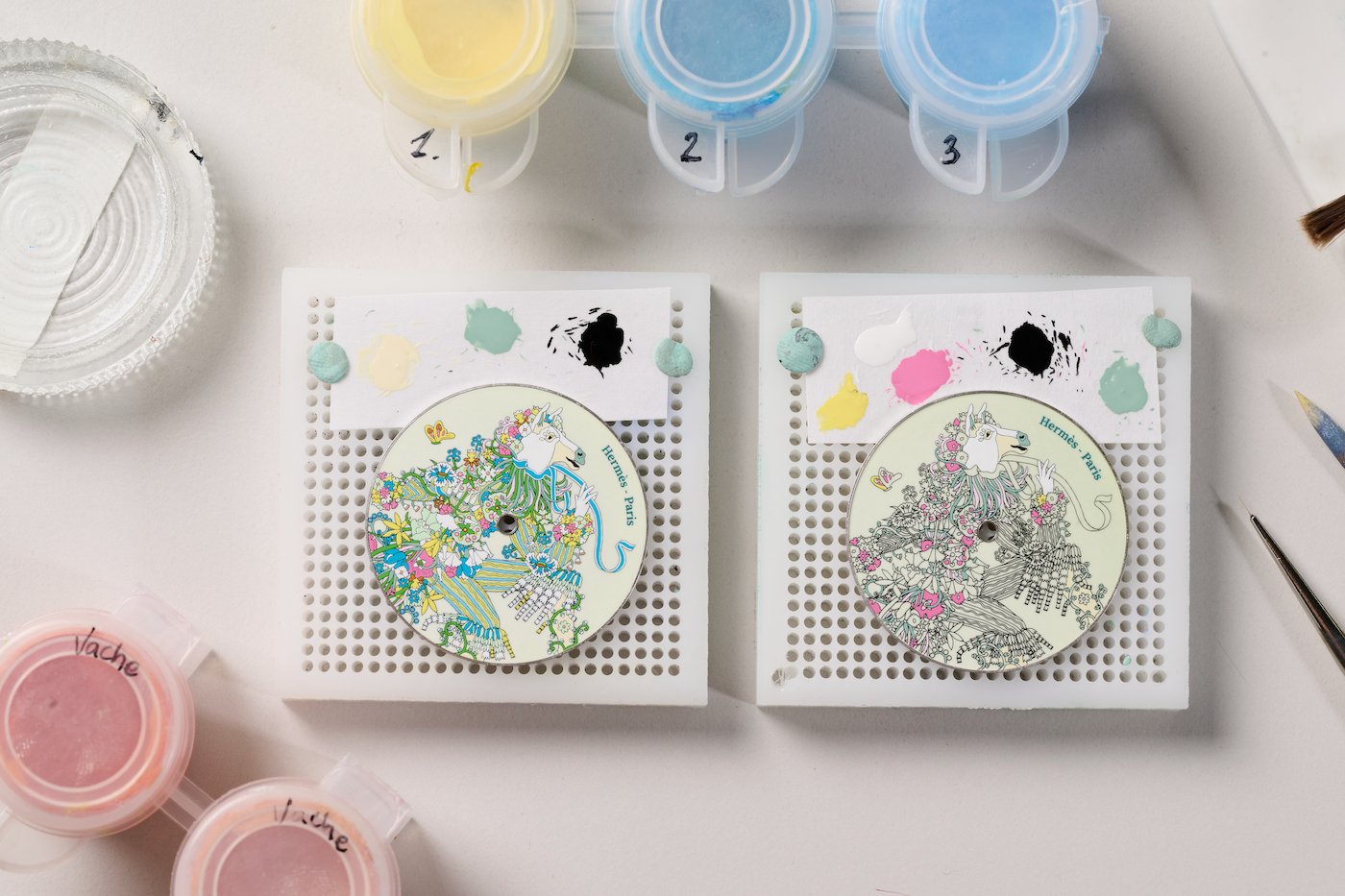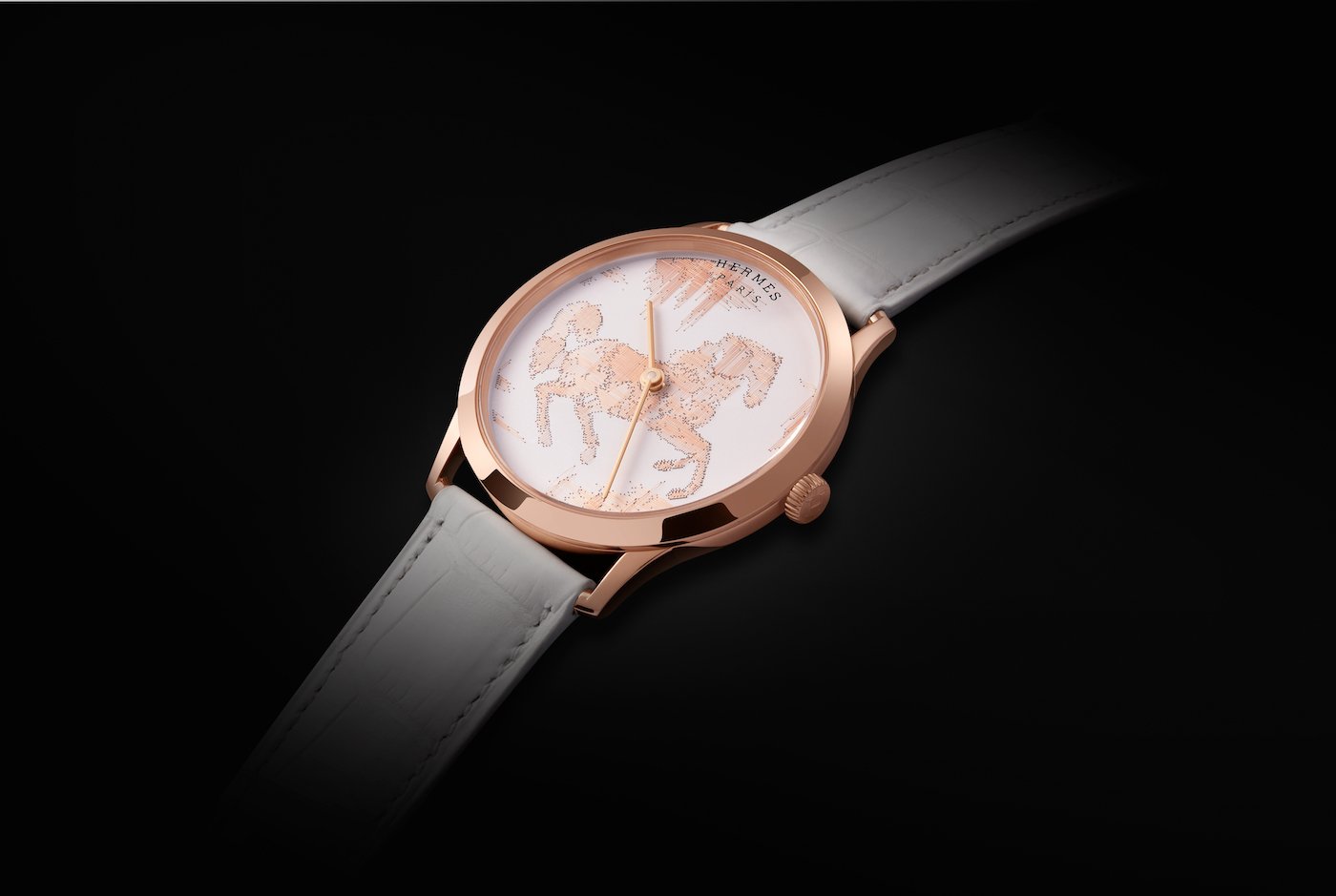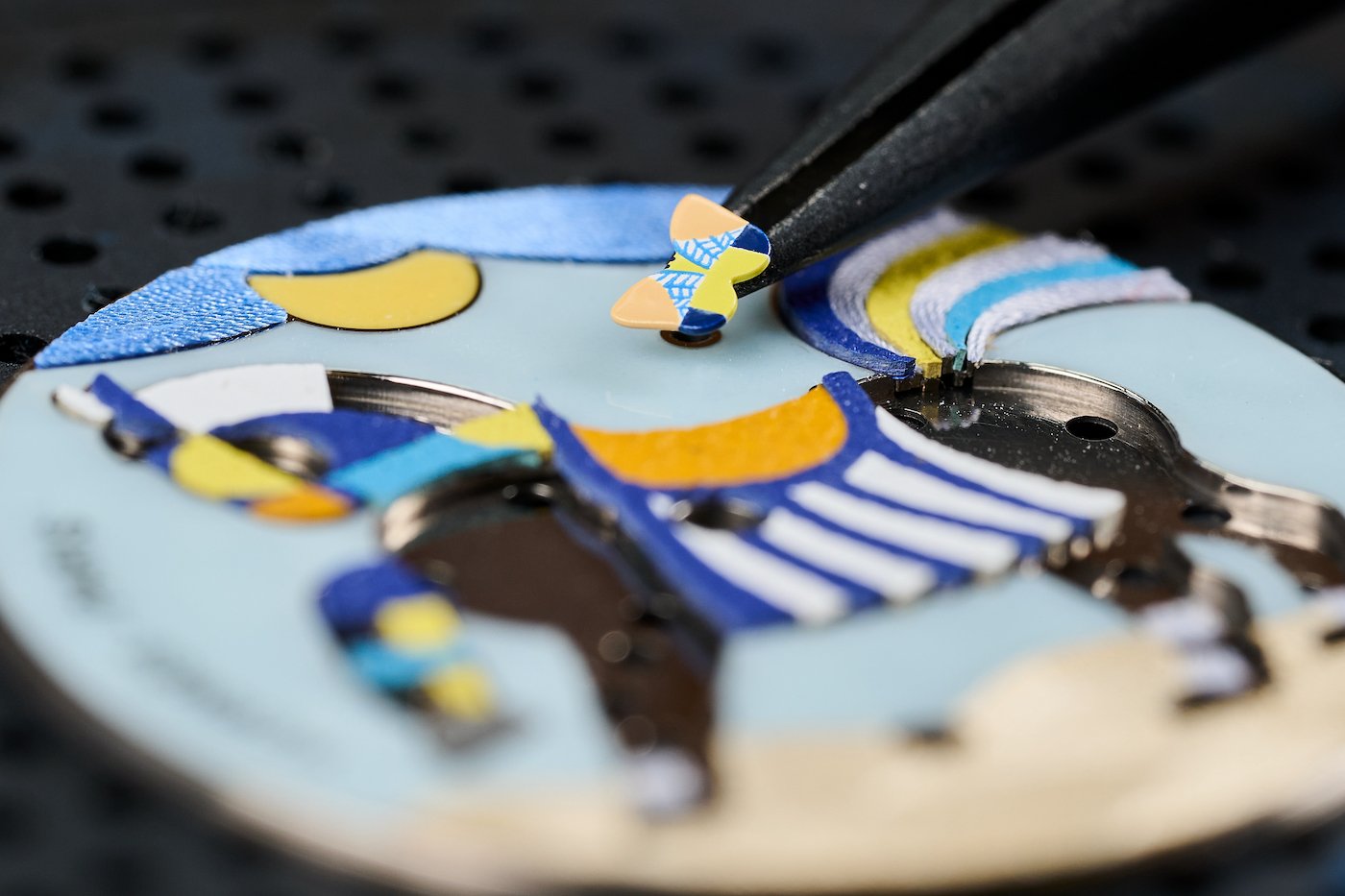ermès Horloger is in good health. With €611 million in sales in 2023, watches account for 5% of the family-owned group’s full-year results, ahead of Perfume and Beauty and hot on the heels of the house’s traditional Silk and Textiles.
This excellent performance, up 23% on 2022, prompted executive chairman of Hermès Axel Dumas to declare that “in 2023, Hermès has once again cultivated its singularity (…). These solid results reflect (…) the commitment and talent of the house’s women and men. I thank them all warmly.”
-

- Hermès 2023 results. Revenue by sector.
The group, which describes itself as a “creator, artisan and seller of high-quality objects”, is an economic powerhouse of colossal size, employing 22,040 people at end December 2023.
-

- Slim d’Hermès Le Sacre des Saisons (2024). Inspired by the silk scarf of the same name, imagined by artist Pierre Marie, this 12-piece limited and numbered edition is a celebration of summer. The engraved and hand-painted sapphire crystal was developed in partnership with Olivier Vaucher and his studio. @Anita Schalefli
Philippe Delhotal, creative director for Hermès Horloger, offers rare insight into some of the many artistic projects completed to date.
Europa Star: For its latest creation, the Slim d’Hermès Le Sacre des Saisons, you took inspiration from a silk scarf of the same name, a design by the artist Pierre Marie. How do you choose a particular theme from such a vast repertoire?
Philippe Delhotal: Hermès can draw upon a multitude of designs and motifs and this is, without any doubt, a rich source of inspiration from which to develop our timepieces. There are numerous themes, from flowers and animals to equestrian, geometric or more contemporary.
Silk is one of our many inspirations. We might also explore a particular subject to imagine our own design, or take up a theme at the suggestion of a master craftsperson, for example the Slim d’Hermès Koma Kurabe. Using the Aka-e porcelain painting technique, master artist Buzan Fukushima transports us to the Japan of traditions, in the shade of a flowering cherry tree, to enjoy the Koma Kurabe horse race, a more than millennial-old celebration.
In addition, each year the house’s artistic director Pierre-Alexis Dumas defines a theme which is also important. It offers a wealth of content and an endless variety of creative expression for the artisan.
-

- Slim d’Hermès Koma Kurabe (2015). On a porcelain dial crafted by Manufacture de Sèvres, master artist Buzan Fukushima honours the millennial-old Koma Kurabe horse race which takes place once a year at the Kamigamo Shrine (built 678) in Kyoto. He is one of the rare artisans to perpetuate the Aka-e technique of porcelain painting finished with a fine layer of gold.
For a long time, watchmaking was an infrequent visitor to the métiers d’art. So-called “artistic” dials were the exception rather than the rule, and were often dependent on the tenacity and aesthetic culture of a small number of CEOs. To be frank, the majority of brands didn’t see them as commercially viable. Since your arrival as creative director for Hermès watches, you’ve turned these conventions upside down by daring to combine materials and craft techniques which were unheard-of in the watch world. An example would be the Arceau Millefiori collection, with its layers of Saint-Louis crystal. How do you reconcile the métiers d’art with the industrial requirements that are inherent to watchmaking and do you ever feel limited artistically?
Hermès is about creativity, hence we believe that technique must always be at the service of creation. I work from the principle that compromise will never do justice to a piece.
Once we have selected the design, I choose the most suitable technique that will bring this design to life on the dial.
In my mind, there are no limits. We know the story we want our dials to tell, and the effect we want the materials, volumes and reliefs to create, and the choice of techniques follows naturally.
-

- Arceau Millefiori pocket watch (2015). Crystal case crafted using the Cristalleries Saint-Louis millefiori technique for paperweights. Shaded grey enamel dial on a white gold base with champlevé numerals in white gold.
Rose Saneuil, a multi-material marquetry artist, says that “every material is an encounter.” Which are your favourite materials and which would you like to meet on a Hermès dial?
I have a soft spot for leather, which has strong associations with Hermès. Leather has great warmth, is a lovely material to work with and has wonderful storytelling qualities through its feel, smell and the sound it makes in your hand. We can use leather to add vibrant as well as muted colour to our dials, as fits the design.
For a number of years, Hermès has been making dials that are a conversation between different métiers d’art. It’s not unusual for one of our dials to associate enamel with leather or engraving, or to have a wood marquetry applique on a hand-painted aventurine dial.

Consolidating an artisanal technique is a potentially infinite process of trial and error during which, as enamellist Anita Porchet reminded us, the artisan is “always on a knife-edge.” Is this compatible with a business’s legitimate objective to be profitable?
Hermès’s artisanal model puts people, creativity and quality at the centre of our reflections. This philosophy allows us to take however long is necessary to do things properly and gives creatives and craftspeople all the time they need to elaborate their ideas and perfect their techniques and their work.
Kintsugi is a Japanese technique for restoring broken porcelain and pottery using a lacquer mixed with powdered gold. Items thus repaired often sell for more than the original piece. From imperfection comes beauty. At what point in your creative process do you decide to no longer correct what some might see as a defect and embrace these imperfections as an integral part of the work?
Our métiers d’art watches are all numbered limited editions, made exclusively by hand. Each one is therefore unique, even if it does represent the same design and is executed by the same craftsman or woman. I wouldn’t use the word imperfections but rather interpretations of the design which can express itself in slightly different ways from one piece to another. We are extremely attentive to colours and to the emotion the dial conveys, as well as to the overall aesthetic.
-

- Arceau Mon Premier Galop (2024). A 24-piece limited and numbered edition, inspired by the “Mon Premier Galop” silk scarf whose designer, artist Tong Ren, has an interest in traditional basketwork. Set against a blue backdrop with a yellow sun, both in enamel, a delicate mosaic unfolds, composed of silk threads and some 30 tesserae in various shades of leather, trimmed to half a millimetre thick.
One recurrent criticism of artistic dials concerns how durable they are over time. What is your view? Is it possible, or advisable, to have them restored?
At Hermès Horloger, we strive to produce quality objects which meet the house’s exacting standards. Artistic dials are delicate but can last for decades and even centuries; enamel, for example.
-

- Slim d’Hermès Le Sacre des Saisons (2024). The vividness of Autumn springs to life on a gold dial which has been engraved using traditional burins and chisels. Hand-painted lines and volumes reveal an eagle, poised to take flight. A 12-piece limited and numbered edition in partnership with Olivier Vaucher and his studio. @Anita Schalefli
La Montre Hermès has the industrial capacity to produce part of its dials in-house. What about the métiers d’art? Do you envisage bringing ancestral techniques such as enamelling, engraving and guillochage in-house, giving you complete independence, or do you prefer to cultivate a network of freelance artisans? What would you say is the ideal balance between in-house and outsourced?
Hermès Horloger is a full-fledged manufacture with skills that cover every aspect of watchmaking and 100% Swiss-made production. The vast majority of our dials are crafted in-house, at our manufacture in Le Noirmont, with the exception of certain métiers d’art dials which require a specific savoir-faire.
We have no immediate plans to bring artistic craft skills in-house. We work with craftsmen and women who are all masters of their art and like to challenge them to recreate a large-scale design within a much smaller space. These interactions with artisans from outside the house are important as they nurture our creativity and innovation, and push the boundaries of our creations further each time.
I think it’s equally true that our partner artisans enjoy working with us, on projects that are often full of colour, detail and spontaneity. This allows them to express their technique in an innovative, more lighthearted way, with the additional challenge of working on something so small with such fine detail.
-

- Slim d’Hermès Le Sacre des Saisons (2024). The dial for the Winter model in miniature enamel painting and paillonné enamel was created in collaboration with Ateliers Blandenier. A 12-piece limited and numbered edition. @Anita Schalefli
What relations do you have with your outside partners and how do you bring in an artisan whose métier d’art is new to watchmaking?
This can be through a specific event, in relation to professional or personal experience, or a chance encounter.
It’s vital that I stay in touch with the artisans and their studios. Their materials, tools and techniques never to cease to amaze and are a source of great emotion and inspiration.

Stamping, CNC cutting, even laser engraving are often used as a substitute for hand-guillochage, to save time and therefore reduce costs. Where do you stand on new technologies? Are you the guardian of the flame, categorically opposed to these methods, or are you the pragmatic professional, taking decisions on a case by case basis?
New technologies can bring pleasing aesthetic solutions and a different approach. It’s a question of finding the right balance between the human hand and the assistance a machine can provide.
Take the Slim d’Hermès Cheval Ikat as an example, with its striated abstract motif. No traditional métier d’art could do justice to the design and so, after research, we worked with a studio to develop a new technique known as wire-ball bonding. Gold wires are fused to the surface of the dial, like embroidery threads, to produce a raised motif with areas of varying transparency and density.
Originally developed for electronics production, we adapted the technique and gave it a strong artistic sense, thus transforming it into an authentic métier d’art for dials. But it could never have existed without the initial help of an industrial machine.
Let me give you another example. In 2018 Hermès contacted the Swiss Centre for Electronics and Microtechnology (CSEM) in Neuchâtel. We were looking for a technological innovation that could artistically render the intimacy and delicacy of designer-graphic artist Thanh-Phong Lê’s “Crépuscule” motif. Again, we’d been unable to find the perfect technique to do justice to this dream-like motif, and so we collaborated with the CSEM to create a dial from a silicon wafer.
-

- Slim d’Hermès Cheval Ikat (2019). Originally designed for the electronics industry, wire-ball bonding creates a relief pattern by fusing gold threads, like embroidery threads, to the surface of the dial.
How do you see the future of Hermès artistic dials and can you tell us what the next one will be?
Hermès artistic dials are destined to remain part of our watch collections. These are objects imbued with fantasy, whimsy and emotion which highlight the work of the most remarkable artisans. Hermès likes to take liberties and these dials express this perfectly.
We’ll be presenting a wonderful collection of métiers d’art inside our pavilion at Watches and Wonders Geneva 2024, with a scenography designed by artists. You may want to look out for one watch in particular, which brings to life the offbeat design of a Japanese artist through a combination of multiple craft techniques that includes mobile appliques, engraving and miniature painting.
-

- For the Arceau Millefiori (2015), preparation of a millefiori crystal dial from a multitude of crystal “bonbons”, handcrafted at Cristalleries Royales de Saint-Louis using a nineteenth-century paperweight technique. Once assembled, this colourful bouquet will be captured in a drop of translucent crystal to create the illusion of a bed of flowers.







